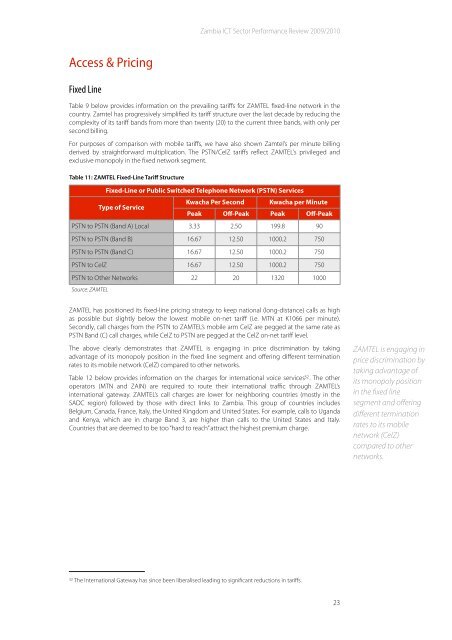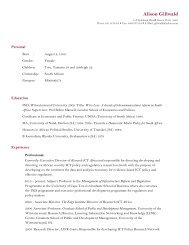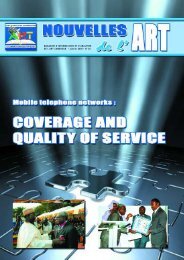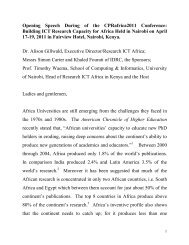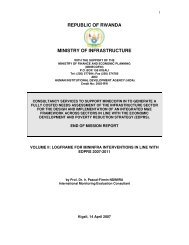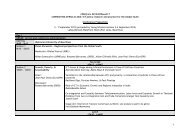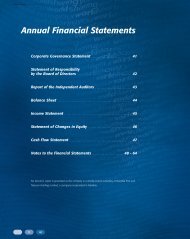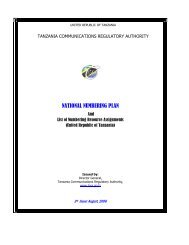Zambia ICT Sector Performance Review 2010 - Research ICT Africa
Zambia ICT Sector Performance Review 2010 - Research ICT Africa
Zambia ICT Sector Performance Review 2010 - Research ICT Africa
Create successful ePaper yourself
Turn your PDF publications into a flip-book with our unique Google optimized e-Paper software.
<strong>Zambia</strong> <strong>ICT</strong> <strong>Sector</strong> <strong>Performance</strong> <strong>Review</strong> 2009/<strong>2010</strong><br />
Access & Pricing<br />
Fixed Line<br />
Table 9 below provides information on the prevailing tariffs for ZAMTEL fixed-line network in the<br />
country. Zamtel has progressively simplified its tariff structure over the last decade by reducing the<br />
complexity of its tariff bands from more than twenty (20) to the current three bands, with only per<br />
second billing.<br />
For purposes of comparison with mobile tariffs, we have also shown Zamtel’s per minute billing<br />
derived by straightforward multiplication. The PSTN/CelZ tariffs reflect ZAMTEL's privileged and<br />
exclusive monopoly in the fixed network segment.<br />
Table 11: ZAMTEL Fixed-Line Tariff Structure<br />
Fixed-Line or Public Switched Telephone Network (PSTN) Services<br />
Type of Service<br />
Kwacha Per Second<br />
Kwacha per Minute<br />
Peak Off-Peak Peak Off-Peak<br />
PSTN to PSTN (Band A) Local 3.33 2.50 199.8 90<br />
PSTN to PSTN (Band B) 16.67 12.50 1000.2 750<br />
PSTN to PSTN (Band C) 16.67 12.50 1000.2 750<br />
PSTN to CelZ 16.67 12.50 1000.2 750<br />
PSTN to Other Networks 22 20 1320 1000<br />
Source: ZAMTEL<br />
ZAMTEL has positioned its fixed-line pricing strategy to keep national (long-distance) calls as high<br />
as possible but slightly below the lowest mobile on-net tariff (i.e. MTN at K1066 per minute).<br />
Secondly, call charges from the PSTN to ZAMTEL’s mobile arm CelZ are pegged at the same rate as<br />
PSTN Band (C) call charges, while CelZ to PSTN are pegged at the CelZ on-net tariff level.<br />
The above clearly demonstrates that ZAMTEL is engaging in price discrimination by taking<br />
advantage of its monopoly position in the fixed line segment and offering different termination<br />
rates to its mobile network (CelZ) compared to other networks.<br />
Table 12 below provides information on the charges for international voice services 32 . The other<br />
operators (MTN and ZAIN) are required to route their international traffic through ZAMTEL’s<br />
international gateway. ZAMTEL’s call charges are lower for neighboring countries (mostly in the<br />
SADC region) followed by those with direct links to <strong>Zambia</strong>. This group of countries includes<br />
Belgium, Canada, France, Italy, the United Kingdom and United States. For example, calls to Uganda<br />
and Kenya, which are in charge Band 3, are higher than calls to the United States and Italy.<br />
Countries that are deemed to be too “hard to reach” attract the highest premium charge.<br />
ZAMTEL is engaging in<br />
price discrimination by<br />
taking advantage of<br />
its monopoly position<br />
in the fixed line<br />
segment and offering<br />
different termination<br />
rates to its mobile<br />
network (CelZ)<br />
compared to other<br />
networks.<br />
32 The International Gateway has since been liberalised leading to significant reductions in tariffs.<br />
23


